
What Are OEM Parts?
OEM parts are defined as automobile parts made by the vehicle’s manufacturer. OEM stands for ‘Original Equipment Manufacturer’. These parts match what came on your vehicle when it rolled off the assembly line. Since they are made by the manufacturer, they match quality, function, performance, and material of the original part that is on your vehicle.
What Are Aftermarket Parts?
Aftermarket mechanical and body parts are not sourced from the vehicle’s manufacturer. They are usually produced by an independent company. These parts are very similar, but are not the same and cannot be categorized as such. These parts are widely used in body shops around the country. They swear that they function the same or better than the original. Our advice – buyer beware. We say this because the quality varies greatly. When low-quality materials are used to keep costs down, an inferior part is born and your safety is compromised. Aftermarket parts are less expensive generally speaking. They are produced by hundreds of companies with the intention of duplicating the OEM part that came on your vehicle. Because the selection is great, the cost is typically less. This also means you can find aftermarket parts pretty much anywhere. There’s so much to choose from with no real certification or manufacturer’s seal of approval to guide your decision.
Questions You Should Ask
When your body shop or mechanic is suggesting the use of an aftermarket part to cut costs, you should ask: Where is the part coming from? This is important because the “aftermarket” description or label put on a mechanical or body part may mean that it came from a wrecked vehicle. That’s right. It may actually be an OEM part that was harvested from a vehicle whose remains are still sitting in the junkyard. Why should this concern you? The general rule for aftermarket part availability is that if the part can be bolted to the vehicle, it can be reproduced. If it had to be welded onto the vehicle, it is an OEM part. When a panel or a door has been cut from a wrecked vehicle to be sold as an aftermarket or recycled part, there is no way to know what stress that part has been under. Just because you may not visibly see damage to this part, doesn’t mean that the stress of the previous wreck did not undermine its integrity to crumple zones. Are you willing to take the chance?
Manufacturer Quality Equals Peace Of Mind
Whether mechanical or body, OEM parts are produced specifically for your make and model vehicle. They are made by the same company who made your vehicle. They match as good as they possibly can. This description applies to OEM parts purchased in new condition. Any dealership parts department can provide you with the exact part you are looking to replace. No guesswork here. No question as to the quality of brands, materials or craftsmanship. The OEM part should fit and work just like the one you are replacing. This assurance of quality provides peace of mind. However, remember that the quality, materials used, function, fit and performance are all guaranteed by the manufacturer. This reduces the stress factor in the repair process.
If you are having your vehicle repaired at a reputable body shop and the insurance company refuses to pay for OEM parts, they may ask you to pay the difference between OEM and aftermarket. You can agree and have OEM used. You can also contest this decision on their part and provide them with manufacturer documentation on safe repairs. Your body shop can assist in this process. Even if you decide to pay a bit extra for the OEM panel, you also gain peace of mind as a bonus.
The short of it, aftermarket parts are always an option, but when your family’s safety is involved – OEM parts are the best choice.
If you enjoyed this article you may also enjoy:
